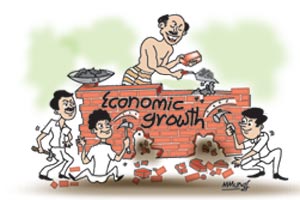
It’s growing, but can it be sustained?
The Central Bank has forecast a continued economic growth of 7 percent for this year. Although the growth rates for the first two quarters of the year are still not available, many statistics of economic performance in the first six months that are available indicate growth in several key areas. They do indicate a reasonably good performance in the production sectors. Whether this performance would sustain a 7 per cent growth is a contentious issue. This is especially so, as there are some sectors that have not performed as well as last year and their poor performance is likely to drag down the growth for the year. These include, most notably, agriculture and sub-sectors in the services sector. Nonetheless we must stress that the economic performance in the first half has been reasonably good.
The industrial sector that contributes around 20 percent of GDP has fared well. Industrial production has increased by about 7 percent. This figure is vindicated by the export statistics. The export of industrial goods grew by 13.5 percent, with the lead industrial export, garments, growing at 14.6 percent. This is indeed good news as it comes on top of a lesser growth of 6.4 percent last year. Although there are continued anxieties about the competitiveness of garments in export markets, recent statistics vindicate the view that there are no serious reasons for anxiety from competitive markets if comparative costs could be maintained. Energy costs, the impact of inflation on wage demands and a possible appreciation of the rupee while the trend of domestic inflation continues however pose concerns. Other industrial exports that grew impressively are leather and rubber goods and food and beverages. Leather and rubber goods grew by an impressive 26.6 percent to give it a significant place among the country's exports. Among these it was leather goods that grew most and holds prospects for future growth. Food and beverages exports grew by 18.6 percent to hold prospects of further growth in the future. The performance of agriculture is a different story. As is the case in agriculture a cyclic pattern of growth and decline related to weather conditions is inevitable, though recent performance indicates a secure growth trend in several important crops. The trend of increasing paddy production was arrested this year with a decline of about 8 percent in the Maha paddy crop at 1,971,000 metric tons compared to 2,136,000 metric tons in the last Maha. The Yala crop figures that would contribute to the year's GDP are estimated to decline by around 4 percent from that of the last Yala. Therefore the decline in paddy production would drag down not only the growth in the first half but the entire year as well. Tea production that is the second most important agricultural sub-sector contribution too declined by nearly 10 percent in the first half of the year. The reasons for the fall in tea production on the estates require attention to prevent a declining trend in estate tea production. Labour unrest was one of the significant causes of lower estate tea production that resulted in a significant decline in estate tea production. In addition there are the concerns of increases in input costs, especially of fertilizer and increases in labour wages and of labour shortages on the plantations. Rubber continued its upward trend in production buoyed by continuing rises in international rubber prices. Rubber production increased by 11.7 percent. The growth in rubber production is, however, constrained by the extent of rubber in bearing having declined and the senility of rubber trees. The setback to the industry by low prices in the past would take time to remedy. Coconut production increased by 9.2 percent in the first six months compared to that of the same period last year. Since paddy and tea contribute 4 percent of GDP, while rubber and coconut together contribute only 1.5 percent of GDP, the increased output in rubber and coconut are not likely to offset the decline in output of paddy and tea. Yet within the agriculture sector, the category of other crops constitutes 59 per cent of agricultural output. Since the production statistics of these crops are highly questionable, their production figures could be massaged to yield a growth in agriculture. Will this happen? Some area in the services sector has had a setback. Tourism that is a significant contributor to output in the services sector declined in the first half of the year. The revival of tourist traffic in August has raised hopes that the second half may witness an improvement in tourist arrivals and foreign exchange earnings. In the first six months however tourist arrivals lessened by 24.4 percent and tourist earnings suffered by 19.6 percent. Since tourism has a number of backward linkages to other sectors this decline would affect other sectors too, especially agriculture, handicrafts, transport and gems and jewellery. However, the services sector as a whole is likely to grow owing to the growth of telecommunications, transport, financial services, public services and military expenditure. The bottom line is that the production sectors have shown a capacity to grow in the face of an inhospitable macro-economic environment of high inflation, depreciation of the currency, higher energy costs and political uncertainty. The pertinent issue is whether the continuation of these unfavourable factors would impinge on the future growth of the economy. The resolution of the macro-economic fundamentals are vital for robust economic growth and these must be addressed even in the face of unfavourable international factors such as rising energy costs and increased military expenditure. A complacency arising out of good economic growth figures could be disastrous for the long-run. |
|| Front
Page | News | Editorial | Columns | Sports | Plus | Financial
Times | International | Mirror | TV
Times | Funday
Times || |
| |
Copyright
2007 Wijeya
Newspapers Ltd.Colombo. Sri Lanka. |
